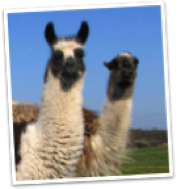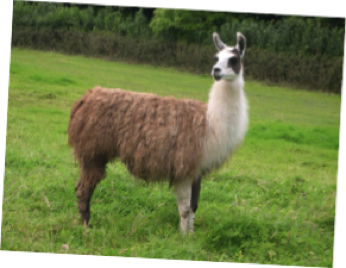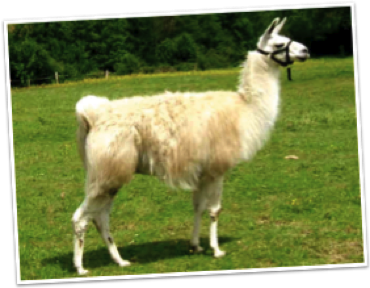About Me
An adult llama may stand up to 6 feet tall and weigh up to 450 pounds. Their most distinct features are their large head and long banana shaped ears. Llamas vary in color and may be black, white, brown, gray, spotted, and even speckled. Llamas look similar to their larger cousins, the camel. All of the South American camelids have a long neck, elongated body, strong refined legs, and three independently moving lips that allow them to grasp their food. Llamas can spit, but they rarely spit at humans. They use spitting and varying pitches of humming sounds as a means to communicate with other members of their herd.
There are no known wild llamas, and as such they are not considered a wild animal. They are very social animals, usually living in large herds maintained by herdsman. When well socialized, llamas are very personable, and curious. Llamas are intelligent, and learn tasks with few repetitions. This has made them an ideal beast of burden for the native people of South America for hundreds of years.
Llamas have long thick wool and cloven hooves that make them sure-footed over the rough terrain, and they are able to survive with little water and on a wide variety of plants, making them durable and dependable in the harsh mountain environment.

Name: Llama
Scientific: Lama glama
Family: Camelidae
Relatives: Alpaca, Guanaco, Vicuna, Camel
Environment: Mountainous
Origin: South America
Life-span: 35 years
Size: 450








Fast Facts


Snapshot
1. There are no known wild llamas.
2. Can carry up to 75 pounds for 20 miles a day,
depending on their size
3. Llamas rarely spit at humans, but use it and
humming sounds to communicate with members
of the herd.
Llamas are the largest of the South American camelids. They are well suited to the cold climate and high elevation of the Andes Mountains.



For centuries, indigenous people have used llamas for meat, and as pack animals to transport goods through the mountains.
Pack
People use llamas to pack goods through the rough terrain of the Andes Mountains. Depending on their size, each llama can carry up to 75 pounds for nearly 20 miles a day. Llama trains are created by tying several hundred llamas loaded with goods together. An overloaded llama may become frustrated, and will generally lay down and refuse to continue. When the weight is lightened, they will continue to walk. A llama’s curious nature makes them willing companions even on the roughest trails. More recently, people have used llamas to assist in backpacking through National Parks, and on mountain climbing adventures.

Fiber
Llama wool is soft and contains no lanolin, which is the grease found in sheep’s wool. Like sheep, llamas are usually sheared once a year, in the Spring. This allows for their warm coat to grow back by the cold winter months, but helps keep them cool in the summer. The llama’s wool can be used almost immediately after it is sheared from the animal with only minor cleaning to remove dirt and vegetation. It the then used to make clothing, blankets, figurines, rugs, and other products. Because llamas come in a wide variety of colors, their wool can be used with each color individually, or by combining it to make many color combinations without dying the fleece.
Guard Animal
In the United States, single llamas are often used as guard animals. Llamas quickly bond with nearly any herd of animals including horses and cows, but are particularly fond of sheep and goats. Llamas usually feel especially protective over the young of a herd they were with before the offspring were born. They will then take on the role of protector against many predators including coyotes and snakes. Commonly a guard llama is a gelded male starting at 2 years of age, and not necessarily well socialized with humans to encourage them to bond with their charges. This is not always the case, however. Some people have llamas who are considered a family pet, but who also live with and watch over the other livestock.
Meat
Like most other animals who serve a purpose while living, llamas may eventually be used for their meat. They have a lean carcass, but the meat is tender and low in fat. Llamas are not considered a high production meat industry like cattle or pigs. However, in rural areas of South America, they have been used as a food source for centuries because they can survive on limited vegetation and with the minimal water available in the sparse mountain regions.


